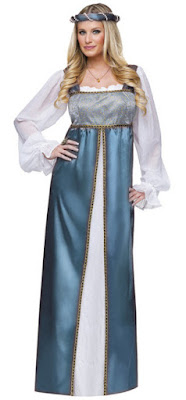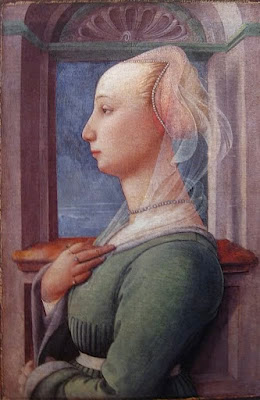On accessories
Maybe it's perfect, beautiful, hand-stitched in period fabrics! Or maybe it barely hit the minimum standard for putting a thing on your body. Either way, it feels like it's missing... something. That last touch to make it clothing instead of a costume.
The answer lies in strategic styling.
What does strategy have to do with it?
It's fairly common knowledge among costumers that accessories can make or break an outfit, but feeling out that line is tricky. With too little embellishment, your garment looks like a party-store costume. Let's talk about using research and a little creativity to accessorize your period garments in a believable way.
 |
| I could say a lot more about this than "it looks a little plain," but... Source: Halloween Express |
Choosing wisely
If you've got a garment to wear already, then you're off to a great start! You know the time, place, and social class to be portrayed. You might even have reference images saved. The most important information you can have at this step is what real people looked like.
Take good Lady Capulet up there. No one would mistake her for a real Veronese matron, but why is that?
 |
| Woman's Portrait by Filippo Lippi, c. 1440 Source: Artists and Art |
This Italian Renaissance portrait depicts a woman of high status whose standing is evident in her accessories and styling. She wears a choker of pearls, which also edge her headpiece; a fine silk veil covers her hair; multiple rings adorn her fingers. These touches are simple but powerful.
Compare Lady Renaissance to Lady Halloween. The latter is obviously styled to modern tastes. Even if the dress stayed the same, merely removing some makeup and pinning up the hair would transform the entire effect without spending an additional cent.
 |
| Progress. |
It takes some work to figure out which elements will make you look like you walked right out of history. The best thing to do is look at art from the period and take notes. Is there an accessory that everyone wears? How is the hair styled, if it's visible at all? What kind of jewelry is common? To borrow a term from my other life as an academic, seek out the diagnostic features that make you say, "Oh, yeah, that's definitely [insert target period here]." Google is your new best friend.
Remember, though, that more isn't always more, depending on the kind of person you intend to portray. If you're Queen Elizabeth, then certainly, layer on the gold and pearls and damask! Drape another ten yards of silk taffeta into that skirt! Go wild! For those of us angling toward the lower end of society, though, the challenge becomes balancing period detailing with believability. I could edge my Elizabethan shift in all kinds of lace, wear draping chains, put blackwork all over my coif – but a working woman in a sturdy wool kirtle would look pretty ridiculous wearing all that as she goes about her everyday chores.
Let's look at Lady Halloween again. The basic dress is simple. A long split-front skirt, a high-waisted bodice, and some small gold trim. This could easily be any well-off lady of Renaissance Italy (as long as we ignore issues of accurate materials and construction). How can we use minor accessories to historicize the impression of this costume? From a quick search for Italian Renaissance portraiture, I've picked out two diagnostic features that I think would elevate the impact of the original dress without getting gaudy: veiling and sleeves. A veil can be as simple as a rectangle of white cloth. Sleeves are more complex, but still easily constructed, and historically were often detachable for versatility. Two simple additions, let's go!
 |
| wHo Is ShE |
If Lady Halloween were more invested in a high-status portrayal, there are plenty of other pieces she could add to this ensemble – an overdress, fancier sleeves, more jewels, complex headgear – but even a couple of small tweaks can make a big difference.
Once you've identified what elements will join your basic garments, it's time to figure out how.
Making it happen
Just like with fabrics, there are vendors out there who offer stunning reproductions of period accessories, but quality goods come at a price. I'm working on a budget!
As I said in my last post, there are many cheap alternatives when it comes to these little touches, although you may pay with your own time. It's up to you to decide where to invest time and money.
For a quick fix: ribbon. If you can find one that looks appropriate for your place/time/status, go ham. I love grosgrain ribbon and twill tapes for trimming garments; a narrow black satin ribbon tied around the neck is a spot-on addition to a late 18th-century ensemble.
 |
| Featuring polyester grosgrain skirt guarding and a belt that I probably got at Target in 2011. Much Elizabethan, so accuracy |
For a little more flair: the jewelry section of the craft store. My coral necklace (featured in the top photo of this post)? 2 strands of beads from the sale shelf at Michaels strung onto a sturdy thread and finished with cheap brass clasps.
 |
| Blue ribbon, gold sequins, and tiny glass beads dress up an otherwise unremarkable Regency reticule. |
For the over-invested: embroidery. I was gifted a stash of DMC cotton floss about 15 years ago and it's still going strong, from eyelets to belt purses. It doesn't have to be fancy, either. Some whip-stitches in black thread around the edge of a white collar can make a huge statement.
 |
| Step 1: find original 1812 embroidery pattern. Step 2: agonize. |
Start small
The options are overwhelming, I know, but remember that you don't – and shouldn't – have to wear all the accessories, all the time. Start with one thing that calls to you and is attainable. It's about adding depth of character to the garments in whatever way feels appropriate to you, not about doing everything at once. If you want to learn knitting or embroidery yourself, do it! If you want to stop at sewing and never touch another type of craft so-help-you-god, I'll meet you in the ribbon aisle.
How do you accessorize historical garments? What are some other ways to get creative when sewing various things?


Comments
Post a Comment